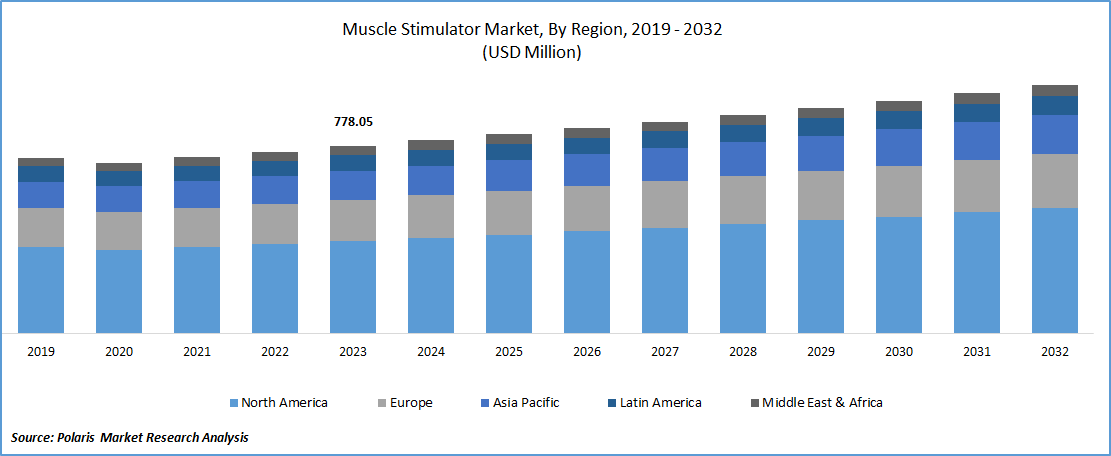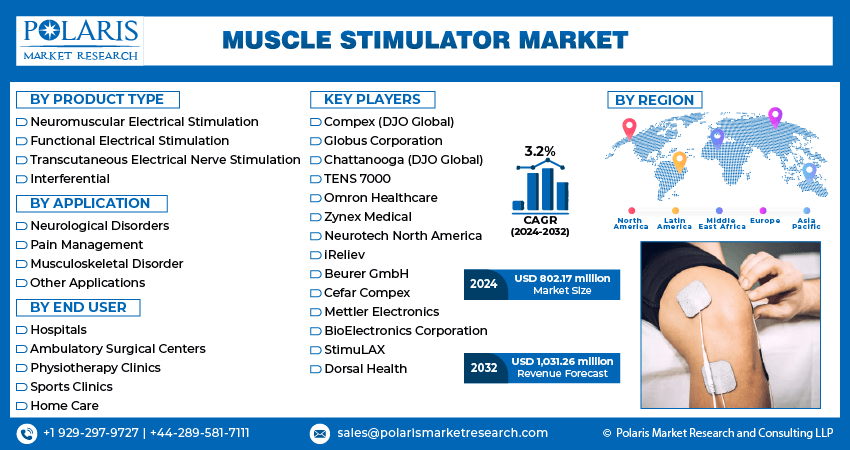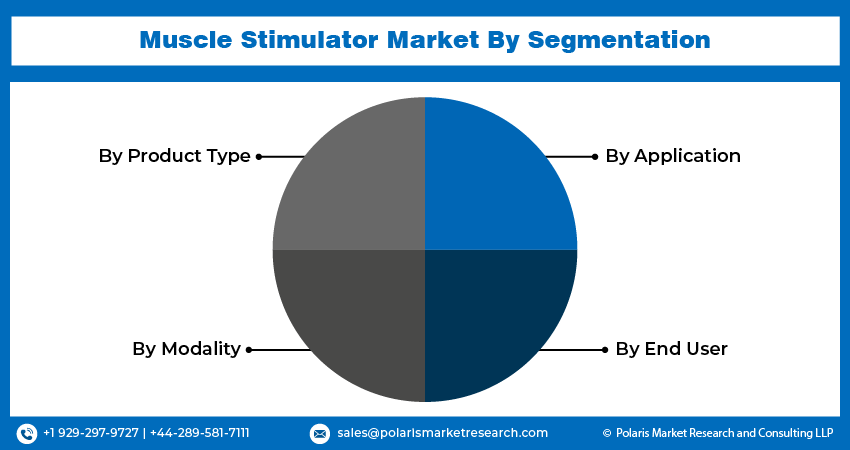
Muscle Stimulator Market Size, Share, Trends, Industry Analysis Report: By Product Type, By Application (Neurological Disorders, Pain Management, Musculoskeletal Disorder, and Other Applications), By End User, and By Region (North America, Europe, Asia Pacific, Latin America, and Middle East & Africa) – Market Forecast, 2024–2032
- Published Date:Aug-2024
- Pages: 115
- Format: PDF
- Report ID: PM5027
- Base Year: 2023
- Historical Data: 2019-2022
Report Outlook
The global muscle stimulator market size was valued at USD 778.05 million in 2023. The market is projected to grow from USD 802.17 million in 2024 to USD 1,031.26 million by 2032, exhibiting a compound annual growth rate (CAGR) of 3.2% during the forecast period.
The muscle stimulator market encompasses devices designed to apply electrical impulses to muscles, enhancing strength, recovery, and rehabilitation. It serves athletes, physiotherapists, and consumers seeking fitness and health benefits.
The global muscle stimulator market is experiencing significant growth, driven by the rising prevalence of musculoskeletal disorders, increasing adoption of fitness and rehabilitation therapies, and the growing geriatric population. Key trends in the market include advancements in wearable technology, integration with mobile applications for personalized therapy plans, and the development of portable and user-friendly devices. Additionally, the increasing awareness about the benefits of muscle stimulation in enhancing muscle strength, endurance, and recovery is propelling market expansion.

To Understand More About this Research:Request a Free Sample Report
Muscle Stimulator Market Outlook
Integration with Mobile Applications
Modern muscle stimulators are increasingly being designed to connect with smartphones and tablets, providing users with enhanced control and customization options. Through dedicated apps, users can adjust intensity levels; choose specific programs for pain relief, muscle strengthening, or recovery; and track their progress over time. This trend is driven by the growing consumer demand for personalized healthcare solutions and the convenience of managing therapy sessions through familiar mobile devices. The integration of advanced analytics within these apps also allows for better monitoring of treatment efficacy and can provide valuable data for healthcare providers. Therefore, integration of these stimulators with mobile applications is expected to emerge as a future trend in the muscle stimulator market.
Advancements in Wearable Technology
Wearable muscle stimulators are becoming more compact, lightweight, and discreet, making them easier for users to incorporate into their daily routines. These devices are available with various specifications such as wireless features, rechargeable batteries, and flexible electrodes that can be comfortably worn under clothing. The trend toward wearables is fueled by the increasing focus on portability and the need for continuous, on-the-go therapy options. This innovation enhances user compliance and broadens the application of muscle stimulators from clinical settings to everyday use, thereby expanding the market reach. Owing to such advancements, the demand for wearable muscle stimulators is expected to increase in the coming years.
Growing Popularity in Sports and Fitness
Athletes and fitness enthusiasts are increasingly using these devices to enhance their training routines, improve muscle strength, and accelerate recovery times. Muscle stimulators are valued for their ability to target specific muscle groups, reduce soreness, and prevent injuries. The trend is supported by endorsements from professional athletes and trainers, as well as the increasing availability of consumer-friendly devices that are designed for use in gyms, at home, or during travel. As the sports and fitness industry continues to emphasize performance optimization and recovery, the demand for effective muscle stimulation technology is expected to rise during the forecast period.

Muscle Stimulator Market Segment Insights
Muscle Stimulator Market Product Insights
Based on product type, the global muscle stimulator market is segmented into neuromuscular electrical stimulation (NMES), functional electrical stimulation (FES), transcutaneous electrical nerve stimulation (TENS), and interferential. The transcutaneous electrical nerve stimulation (TENS) segment dominates the market as it is highly popular among healthcare providers and patients due to its widespread application in pain management and its noninvasive nature. TENS devices are extensively used for chronic pain relief, post-surgical recovery, and various musculoskeletal condition management, which drives their substantial market share. The ease of use, affordability, and availability of TENS units have also driven the segment in the market.
The Neuromuscular Electrical Stimulation (NMES) segment is projected to experience the highest growth rate during the forecast period. This growth is propelled by the increasing adoption of NMES devices in rehabilitation and physical therapy settings, particularly for muscle re-education, strengthening, and preventing muscle atrophy in patients affected by injuries or neurological disorders. The advancements in NMES technology such as the development of portable and user-friendly devices and their growing acceptance in sports medicine for enhancing athletic performance and recovery, contribute to the rapid expansion of this segment. The rising awareness about the benefits of NMES in clinical and home settings is expected to boost its demand in the coming years.
Muscle Stimulator Market – Modality-Based Insights
The global muscle stimulator market, by modality, is bifurcated into handheld and portable. The portable segment dominates the market, owing to its versatility, ease of use, and convenience for users. Portable muscle stimulators are favored for their compact design and the ability to be used anywhere, which makes them ideal for clinical settings and home use. Their user-friendly interfaces and the ability to offer a wide range of stimulation programs have contributed to their widespread adoption. The emerging trend of remote patient monitoring and self-administered therapy would propel the demand for portable devices, ensuring their dominant position in the market.
The handheld segment is experiencing a higher growth rate, driven by the increasing focus on innovative designs and advanced features that cater to specific therapeutic needs. Handheld muscle stimulators are gaining popularity due to their precision and targeted application, making them particularly effective for localized muscle therapy and pain relief. The integration of smart technology, such as Bluetooth connectivity and app-based controls, in handheld devices is enhancing their functionality and appeal. Additionally, the growing awareness of muscle stimulation benefits in sports recovery, fitness training, and rehabilitation is boosting the demand for these advanced handheld devices, positioning them as the fastest-growing segment in the market.
Muscle Stimulator Market – Application-Based Insights
The global market, by application, is segmented into neurological disorders, pain management, musculoskeletal disorder, and other applications. The pain management segment dominates the market owing to the widespread use of muscle stimulators in treating chronic pain, postoperative pain, and various musculoskeletal conditions. Devices such as Transcutaneous Electrical Nerve Stimulation (TENS) are extensively utilized in clinical and home settings for their efficacy in pain relief. The high prevalence of chronic pain conditions globally, coupled with the increasing preference for noninvasive pain management solutions, has solidified pain management as the leading segment in the muscle stimulator market.
The musculoskeletal disorder segment is expected to register the highest growth rate during the forecast period. This growth is driven by the rising prevalence of musculoskeletal disorders due to increasing aging population, surging adoption of sedentary lifestyles, and growing cases of sports injuries. Muscle stimulators, particularly Neuromuscular Electrical Stimulation (NMES) devices, are increasingly adopted for rehabilitation, muscle re-education, and preventing muscle atrophy. Advances in technology, such as the development of portable and user-friendly NMES devices, and their integration into comprehensive physical therapy programs, are significantly boosting the demand for muscle stimulators in this segment. Additionally, the growing awareness about the benefits of muscle stimulation in enhancing muscle strength and recovery is expected to drive the market expansion for the musculoskeletal disorder segment during the forecast period.
Muscle Stimulator Market – End User-Based Insights
The global market, by end user, is segmented into hospitals, ambulatory surgical centers, physiotherapy clinics, sports clinics, and home care. The hospitals segment dominates the market. Hospitals are the primary centers for the treatment of acute and chronic pain, post-surgical rehabilitation, and various neurological and musculoskeletal disorders. The availability of advanced muscle stimulator devices, combined with the presence of skilled healthcare professionals, makes hospitals the preferred choice for comprehensive treatment plans. Additionally, the higher patient influx in hospitals and the ability to provide personalized and intensive care contribute to their leading market share.
The home care segment is registering the highest growth rate, driven by the increasing demand for convenient, cost-effective, and noninvasive treatment options. The rising prevalence of chronic diseases, growing elderly population, and increasing preference for home-based healthcare are key factors fueling this growth. Portable and user-friendly muscle stimulators are gaining popularity among patients for their ease of use and the flexibility to administer therapy at home. Technological advancements such as wireless devices and mobile app integration are enhancing the appeal of home care muscle stimulators. As awareness about home-based muscle stimulation benefits spreads, and as patients seek to avoid frequent hospital visits, the home care segment is expected to continue its rapid expansion.
Muscle Stimulator Market, Segmental Coverage, 2019 - 2032 (USD million)

Source: Secondary Research, Primary Research, PMR Database and Analyst Review
Muscle Stimulator Market Regional Insights
By region, the study provides the market insights into North America, Europe, Asia Pacific, Latin America, and the Middle East & Africa. The global muscle stimulator market is dominated by North America, primarily due to the region's advanced healthcare infrastructure, high prevalence of chronic pain and musculoskeletal disorders, and strong adoption of innovative medical technologies. The US, in particular, leads in market share owing to its substantial investments in healthcare research and development, a high rate of medical device utilization, and a well-established healthcare system that supports the use of advanced muscle stimulators. Additionally, the growing awareness of pain management and rehabilitation therapies among patients and healthcare providers in North America contributes to the region's leading position in the market. The presence of key market players and a strong focus on technological advancements solidify North America's dominance.
Muscle Stimulator Market, Regional Coverage, 2019 - 2032 (USD million)

Source: Secondary Research, Primary Research, PMR Database and Analyst Review
In Europe, the muscle stimulator market is characterized by a strong presence of advanced healthcare systems and a growing focus on rehabilitation and pain management therapies. Countries such as Germany, France, and the UK are leading the market due to their well-developed healthcare infrastructure and increasing adoption of innovative medical technologies. The European market benefits from supportive government regulations and funding for research and development in medical devices. Additionally, the rising prevalence of chronic diseases and musculoskeletal disorders across the region propels demand for muscle stimulators. However, market growth may be moderated by stringent regulatory requirements and varying healthcare policies across different European countries.
The muscle stimulator market in Asia Pacific is experiencing significant growth, driven by rapid economic development, increasing healthcare investments, and rising awareness of physical therapy and pain management. Countries such as China, India, and Japan are major contributors to this growth. The large and growing patient population, coupled with increasing disposable incomes and improvements in healthcare infrastructure, are fueling demand for muscle stimulators. Additionally, the rising prevalence of chronic conditions and the expanding healthcare access in emerging markets contribute to the region’s robust market expansion. The Asia Pacific market is expected to witness rapid growth due to ongoing advancements in medical technologies and increasing healthcare expenditure.
Muscle Stimulator Market – Key Players and Competitive Insights
In terms of competitive analysis, the muscle stimulator market is marked by a mix of established players and emerging companies. Major players such as Compex and DJO Global dominate the market with a broad portfolio of advanced devices and strong distribution networks. These companies invest significantly in R&D to innovate and enhance device features, such as integration with mobile apps and wireless technology. Meanwhile, entrants and regional players, including iReliev and BioElectronics, are gaining traction by offering cost-effective and user-friendly solutions, focusing on niche markets and personalized therapy.
The competitive landscape is shaped by continuous technological advancements and strategic initiatives, including mergers and acquisitions, partnerships, and product launches. Companies are leveraging these strategies to expand their market presence and offer differentiated products. For instance, advancements in wearable technology and portable devices are gaining momentum, with players investing in developing smart, connected solutions to meet the evolving demands of consumers and healthcare providers. Overall, the market is dynamic, with key players striving to maintain a competitive edge through innovation, strategic partnerships, and expanding their product offerings.
Compex (DJO Global), Globus Corporation, Chattanooga (DJO Global), TENS 7000, Omron Healthcare, Zynex Medical, Neurotech North America, iReliev, Chattanooga (DJO Global), Beurer GmbH, Cefar Compex, Mettler Electronics, BioElectronics Corporation, and StimuLAX are a few key players in the global muscle stimulator market. These companies are prominent for their diverse range of muscle stimulation devices, including TENS units, NMES devices, and advanced wearable technologies, catering to various applications such as pain management, rehabilitation, and muscle strengthening.
Compex, a subsidiary of DJO Global, is a major player in the muscle stimulator market known for its advanced range of electrical stimulation devices used in pain management, muscle recovery, and rehabilitation. The company offers products such as the Compex SP 8.0 and Compex Performance series, which are popular among athletes and physical therapists for their high efficacy and innovative features. Compex is recognized for its commitment to technological innovation and user-friendly designs.
Omron Healthcare is a prominent global player in the muscle stimulator market, offering a range of devices designed for pain relief and muscle stimulation. Known for its TENS units, such as the Omron HV-F128 and Omron Electrotherapy Pain Relief Unit, Omron Healthcare focuses on integrating advanced technology with ease of use. The company is renowned for its high-quality products and commitment to improving patient care through innovative solutions.
Key Companies in Muscle Stimulator Market
- Compex (DJO Global)
- Globus Corporation
- Chattanooga (DJO Global)
- TENS 7000
- Omron Healthcare
- Zynex Medical
- Neurotech North America
- iReliev
- Beurer GmbH
- Cefar Compex
- Mettler Electronics
- BioElectronics Corporation
- StimuLAX
- Dorsal Health
Muscle Stimulator Industry Developments
- In July 2024, Omron Healthcare introduced the "Omron Smart Pain Relief" device, which combines advanced TENS technology with smart sensors.
- In August 2023, Compex announced the launch of its new "Compex Wireless USA" series, featuring enhanced wireless connectivity and app integration for more personalized therapy management.
Muscle Stimulator Market Segmentation
Muscle Stimulator, by Product Type
- Neuromuscular Electrical Stimulation
- Functional Electrical Stimulation
- Transcutaneous Electrical Nerve Stimulation
- Interferential
Muscle Stimulator, by Modality
- Handheld
- Portable
Muscle Stimulator, by Application
- Neurological Disorders
- Pain Management
- Musculoskeletal Disorder
- Other Applications
Muscle Stimulator, by End User
- Hospitals
- Ambulatory Surgical Centers
- Physiotherapy Clinics
- Sports Clinics
- Home Care
Muscle Stimulator, by Region
- North America
- US
- Canada
- Europe
- Germany
- France
- UK
- Italy
- Spain
- Netherlands
- Russia
- Rest of Europe
- Asia Pacific
- China
- Japan
- India
- Malaysia
- South Korea
- Indonesia
- Australia
- Vietnam
- Rest of Asia Pacific
- Middle East & Africa
- Saudi Arabia
- UAE
- Israel
- South Africa
- Rest of Middle East & Africa
- Latin America
- Mexico
- Brazil
- Argentina
- Rest of Latin America
Muscle Stimulator Report Scope
|
Report Attributes |
Details |
|
Market size value in 2023 |
USD 778.05 million |
|
Market size value in 2024 |
USD 802.17 million |
|
Revenue forecast in 2032 |
USD 1,031.26 million |
|
CAGR |
3.2% from 2024 to 2032 |
|
Base year |
2023 |
|
Historical data |
2019–2022 |
|
Forecast period |
2024–2032 |
|
Quantitative units |
Revenue in USD million and CAGR from 2024 to 2032 |
|
Report coverage |
Revenue Forecast, Market Competitive Landscape, Growth Factors, and Trends |
|
Segments covered |
|
|
Regional scope |
|
|
Competitive landscape |
|
|
Report format |
|
|
Customization |
Report customization as per your requirements with respect to countries, region, and segmentation. |
How the report is valuable for an organization?
Workflow/Innovation Strategy: The muscle stimulator market is broadly segmented on the basis of product, modality, application, and end user. Moreover, the study provides a detailed understanding of these segments at regional and global level.
Growth/Marketing Strategy: The growth and marketing strategy for the muscle stimulator market focuses on expanding product portfolios, leveraging technological advancements, and increasing consumer awareness. Companies are investing in research and development to innovate and enhance device features, such as wireless connectivity and integration with mobile apps, to offer personalized and user-friendly solutions. Strategic partnerships and collaborations with healthcare providers and sports organizations are key to broadening market reach and improving product visibility. Additionally, targeting emerging markets with rising healthcare needs and promoting the benefits of muscle stimulators through educational campaigns and digital marketing are crucial for driving market growth and capturing new customer segments
FAQ's
The global muscle stimulator market size was valued at USD 778.05 million in 2023 and is projected to grow to USD 1,031.26 million by 2032.
The global market is projected to record a CAGR of 3.2% during 2023–2032.
North America accounted for the largest market share.
Compex (DJO Global), Globus Corporation, Chattanooga (DJO Global), TENS 7000, Omron Healthcare, Zynex Medical, Neurotech North America, iReliev, Chattanooga (DJO Global), Beurer GmbH, Cefar Compex, Mettler Electronics, BioElectronics Corporation, and StimuLAX are among the key players in the global muscle stimulator market.
By product type, the Transcutaneous Electrical Nerve Stimulation (TENS) segment dominated the market in 2023
Based on modality, the portable segment had a larger share of the global market
A muscle stimulator is a device designed to apply electrical impulses to the muscles through electrodes placed on the skin. These electrical impulses mimic the natural signals sent by the nervous system to stimulate muscle contractions. Muscle stimulators are used for various purposes, including pain management, muscle rehabilitation, muscle strengthening, and recovery
A few key trends in the muscle stimulator market are described below: Integration with Digital Technology: Increasing adoption of smart devices with connectivity features, such as mobile app integration for personalized therapy and real-time monitoring. Advancements in Wearable Technology: Development of compact, lightweight, and discreet wearable muscle stimulators for on-the-go use and enhanced convenience. Growing Focus on Home Care: Rising demand for portable and user-friendly muscle stimulators designed for home use, driven by the preference for self-managed therapy and cost-effective solutions. Increased Adoption in Sports and Fitness: Expanding use of muscle stimulators among athletes and fitness enthusiasts for performance enhancement, muscle recovery, and injury prevention.
For a new company entering the muscle stimulator market, focusing on technological innovation and differentiation can provide a competitive edge. Developing advanced features such as seamless integration with mobile apps for personalized therapy, incorporating wearable technology for enhanced portability, and leveraging AI for tailored treatment plans can set the company apart. Additionally, emphasizing user-friendly designs, robust customer support, and competitive pricing strategies will appeal to consumers and healthcare providers. Targeting emerging markets with growing healthcare needs and creating strategic partnerships with healthcare professionals and sports organizations can further enhance market presence
Companies manufacturing muscle stimulators and devices, firms in the medical devices industry, and other consulting firms
